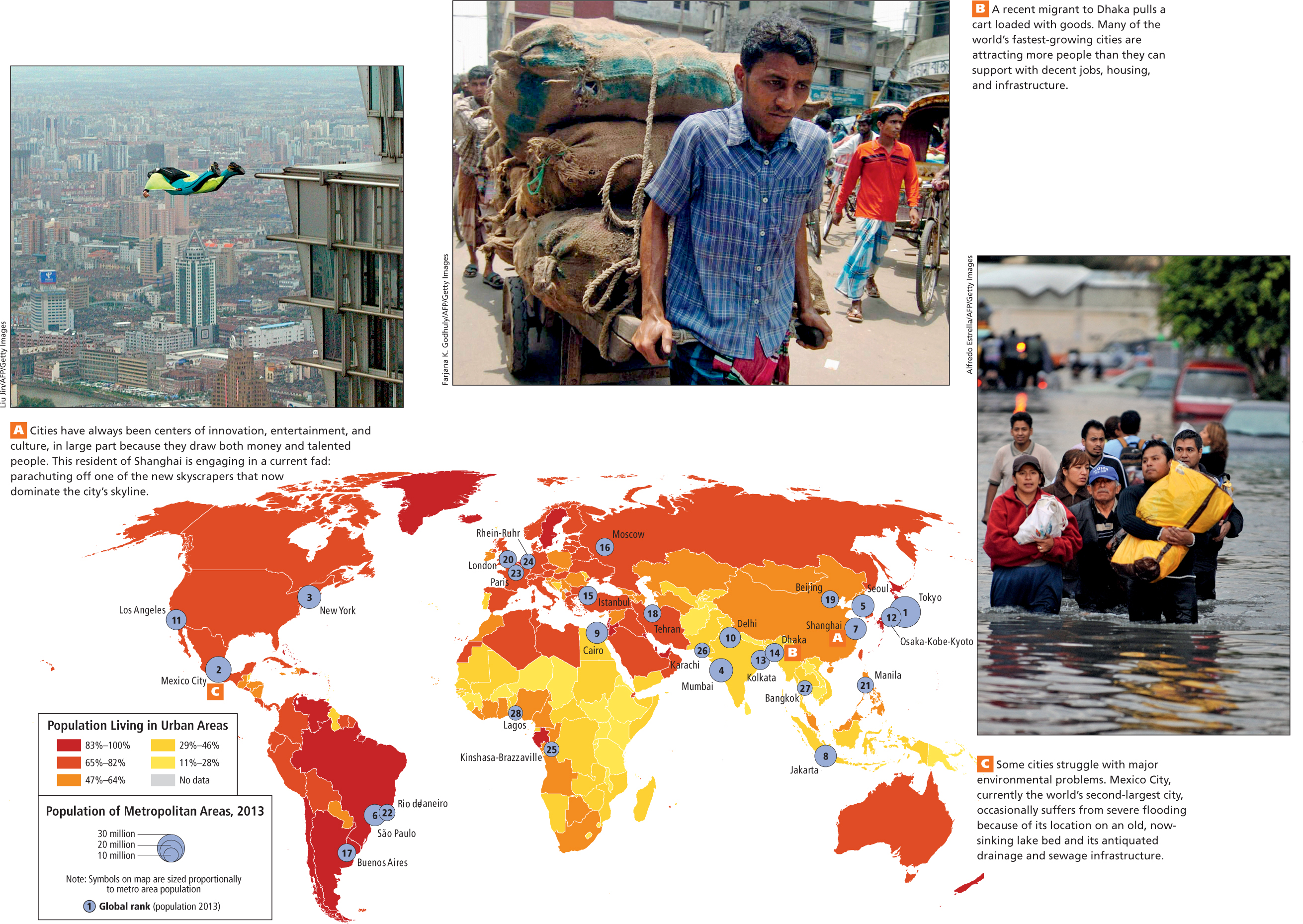1.9 URBANIZATION
GEOGRAPHIC INSIGHT 4
Urbanization: The development of urban manufacturing and service economies has pulled people into cities. Meanwhile, the mechanization of food production has drastically reduced the need for agricultural labor, thus pushing people out of rural areas.
In 1700, fewer than 7 million people, or just 10 percent of the world’s total population, lived in cities, and only 5 cities had populations of several hundred thousand people or more. The world we live in today has been transformed by urbanization, the process whereby cities, towns, and suburbs grow as populations shift from rural to urban livelihoods. A little over half of the world’s population now lives in cities, and there are more than 400 cities of more than 1 million people and 28 cities of more than 10 million people.
urbanization the process whereby cities, towns, and suburbs grow as populations shift from rural to urban livelihoods
1.9.1 WHY ARE CITIES GROWING?
The mechanization of food production has drastically reduced the need for rural labor while also increasing the food supply to the point where large non-

THINKING GEOGRAPHICALLY
Use the Photo Essay above to answer these questions.
Question 1.13
A To what group of urban migrants does this skydiving young man probably belong?
Question 1.14
B In what kind of neighborhood of Dhaka would you guess this man lives?
Question 1.15
C This photo exemplifies what problem commonly faced by rapidly growing cities?
push/pull phenomenon of urbanization conditions, such as political instability or economic changes, that encourage (push) people to leave rural areas, and urban factors, such as job opportunities, that encourage (pull) people to move to the urban area
slum densely populated area characterized by crowding, run-
Patterns of Urban Growth
The most rapidly growing cities are in developing countries in Asia, Africa, and Middle and South America. The settlement pattern of these cities bears witness to their rapid and often unplanned growth, fueled in part by the steady arrival of masses of poor rural people looking for work (see Figure 1.24B). Cities like Mumbai (in India), Cairo (in Egypt), Nairobi (in Kenya), and Rio de Janeiro (in Brazil) sprawl out from a small affluent core, often the oldest part, where there are upscale businesses, fine old buildings, banks, shopping centers, and residences for wealthy people. Surrounding these elite landscapes are sprawling mixed commercial, industrial, and middle-
The UN estimates that currently more than a billion people live in urban slums, with that number to increase to 2 billion by 2030. Life in these areas can be insecure and chaotic as criminal gangs often assert control through violence and looting—
ON THE BRIGHT SIDE
Urban Migrant Success Stories
Slums are only part of the story of urbanization today. Those who are financially able to come to urban areas for education and complete their studies tend to find employment in modern industries and business services. They constitute the new middle class and leave their imprint on urban landscapes via the high-
In the past, most migrants to cities were young males, but increasingly they are young females. Cities offer women more opportunities to work outside the home than do rural areas. And urban jobs usually pay much more than rural jobs. Cities also provide women with better access to education, better health care, and more personal freedom.
THINGS TO REMEMBER
GEOGRAPHIC INSIGHT 4
Urbanization The development of urban manufacturing and service economies has pulled people into cities. Meanwhile, the mechanization of food production has drastically reduced the need for agricultural labor, thus pushing people out of rural areas.
Today about half of the world’s population live in cities; there are over 400 cities with more than 1 million people and 28 cities of more than 10 million people.
For some, urbanization means improved living standards, while for others it means being forced into slums with inadequate food, water, and social services.